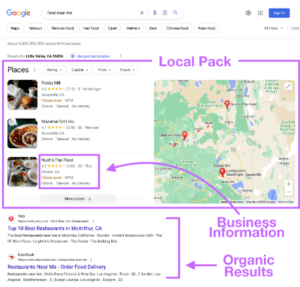97% of search engine users search online to find a local business. If users want to find a local business online, they turn to search engines first.
The Importance of SEO for Roofing Companies
In the roofing industry, standing out from the competition is crucial. SEO for roofing companies helps you be found by potential customers online, bringing more qualified leads to your website.
Quick Wins for Roofing SEO:
- Drive More Traffic: Higher rankings mean more visitors to your site.
- Build Trust: Being on the first page of search results builds credibility.
- Long-term Benefits: Good SEO keeps bringing in traffic without ongoing effort.
Search engine optimization (SEO) can make your roofing business more visible, especially in a highly competitive field. Over 70% of people research companies online before choosing their services, making a strong online presence vital.
At D&D SEO Services, we understand the unique challenges roofing companies face. We offer specialized SEO strategies to help your business rise above the rest and attract more customers.
What is SEO for Roofing Companies?
SEO for roofing companies involves improving your website and its online reputation to rank higher on search engine results pages (SERPs) for keywords related to your industry and services. This process helps potential customers find your business when they search for roofing services online.
Definition
SEO stands for Search Engine Optimization. For roofing companies, it means making your website more attractive to search engines like Google. When done right, SEO helps your site appear higher in search results when people look for roofing services.
Process
The SEO process includes several steps:
- Keyword Research: Identify the terms people use when searching for roofing services.
- On-Page Optimization: Make changes to your website to improve its ranking.
- Content Creation: Publish useful content that answers common roofing questions.
- Link Building: Get other reputable websites to link back to your site.
Keywords
Keywords are the words and phrases people type into search engines. For roofing companies, some important keywords might include:
- Roof repair
- Metal roofing
- Roof leak repair
- Shingle replacement
Using both short-tail (general) and long-tail (specific) keywords helps you reach a wider audience. For example, “roof repair” is a short-tail keyword, while “roof repair Cleveland, OH” is a long-tail keyword.
Search Engine Results Pages (SERPs)

SERPs are the pages you see after typing a query into a search engine. Your goal is to have your roofing company appear at the top of these pages. Higher rankings mean more visibility and clicks.
Why it matters: Being on the first page of search results can significantly increase your chances of getting new customers. According to Forbes, roofing companies that focus on SEO often see higher conversion rates.
With SEO, your roofing business can become more visible online, attract more qualified traffic, and ultimately convert more visitors into customers. At D&D SEO Services, we specialize in crafting SEO strategies tailored to roofing companies, helping you achieve these goals.
Next, let’s delve into the specific benefits of SEO for roofing companies.
Benefits of Roofing SEO

Investing in SEO for roofing companies offers a wide range of benefits. Let’s explore some key advantages:
Drive Qualified Traffic
SEO helps you attract visitors who are actively searching for roofing services. This means the traffic to your website is more likely to convert into leads and, eventually, customers. According to research, over 70% of people research a company online before choosing them. By ranking high in search results, you can capture this audience and drive qualified traffic to your site.
Build Brand Recognition and Trust
When your roofing company appears at the top of search results, it signals to potential customers that you are a trusted and relevant player in the industry. High rankings can help build brand recognition and trust, making it more likely that people will choose your services over competitors.
Reap Long-Term Results
One of the most significant benefits of SEO is its longevity. Unlike paid ads that stop delivering results once you stop paying, a well-optimized website continues to attract traffic and generate leads over time. A high-quality blog post about common roofing issues, for example, can keep driving traffic for years with no additional effort. This makes SEO a sustainable and long-term strategy for growth.
Cost-Effective Marketing
SEO is one of the most cost-effective marketing strategies available. While it requires an upfront investment in terms of time and resources, the ongoing costs are relatively low compared to traditional advertising methods. Over time, the cost per lead generated through SEO decreases, offering a higher return on investment (ROI).
High ROI
Speaking of ROI, SEO provides a high return on investment for roofing companies. By targeting specific keywords and optimizing your website, you can attract highly relevant traffic that is more likely to convert. This means that the money you spend on SEO can yield significant returns in the form of new customers and increased revenue.
Next, let’s delve into how to get started with SEO for roofing companies.
How to Get Started with SEO for Roofing Companies
Conduct Keyword Research
Keyword research is the first step in any SEO strategy. This involves finding the right words and phrases that potential customers use when searching for roofing services. Tools like KeywordsFX or keywordtool.io can help you identify keywords with high search volume, low competition, and reasonable cost-per-click (CPC).
Search volume indicates how often people search for a keyword. Higher search volumes mean more potential traffic, but they also usually come with more competition. Competition measures how many other websites are targeting the same keyword. Lower competition makes it easier for you to rank higher in search results. Cost-per-click (CPC) is useful if you’re considering pay-per-click advertising alongside your SEO efforts. It tells you how much advertisers are willing to pay for each click on an ad featuring that keyword.
Keyword intent is crucial. It shows what the user aims to achieve with their search. For example, “roofing contractors near me” indicates a user ready to hire, while “black roof shingles pros cons” shows a user in the research phase.
Optimize On-Page Elements
Once you’ve identified your keywords, the next step is on-page optimization. This involves placing your keywords strategically on your website to improve your rankings.
Header tags (H1, H2, etc.) help break up your content and make it easier to read. Use your main keyword in your H1 tag and secondary keywords in H2 and H3 tags. Internal links are links within your website that guide users to related content. This keeps visitors engaged and improves your site’s SEO.
User experience (UX) is another key factor. A fast-loading, easy-to-navigate website keeps visitors on your site longer, which can improve your rankings. Adding interactive elements, like quizzes or calculators, can make your site more engaging. For example, Bill Ragan Roofing Company uses an interactive quiz to help users choose the right roofing material.
Create Quality Content
Content creation is at the heart of SEO. High-quality content can double your website’s conversion rates and establish you as a trusted authority in your field. Here are some content ideas:
- Blog posts comparing DIY roof replacement vs. professional services
- Videos on how to know when you need to replace your roof
- Long-form articles on what to look for in a roof when buying a home
- Infographics detailing the pros and cons of different roofing materials
Companies with blogs generate 67% more leads per month than those without. Quality content not only drives traffic but also builds trust and authority.
Link Building
Link building is essential for SEO success. This involves getting other reputable websites to link back to your site, showing search engines that your content is valuable.
There are two types of links to focus on: internal links and backlinks. Internal links connect different pages on your website, improving navigation and SEO. Backlinks come from other websites and are a strong ranking factor.
Effective link-building strategies include:
- Guest posting on other blogs
- Social media sharing to increase visibility
- Online directories to get listed in local and industry-specific directories
- HARO (Help a Reporter Out) to gain media mentions
- Broken link building to replace broken links on other sites with your content
Quality over quantity. A few authoritative backlinks are better than many low-quality ones.
Next, we’ll explore how to optimize your roofing company’s online presence for local search results.
Local SEO for Roofing Companies
When it comes to SEO for roofing companies, local SEO is crucial. Why? Because most people looking for roofing services search for local businesses. Let’s dive into how you can optimize your presence locally.
Google My Business
Creating and optimizing your Google My Business (GMB) profile is the first step. This free tool lets you manage how your business appears on Google Search and Maps.
Steps to Optimize GMB:
- Complete Your Profile: Fill out all sections, including business name, address, phone number, hours, and services.
- Add Photos: Regularly update your profile with photos of your completed projects.
- Get Reviews: Encourage satisfied customers to leave positive reviews. Businesses with more reviews generally rank higher.
- Post Updates: Use the “Posts” feature to share news, offers, and updates.
Local Directories
Listing your business in local directories can significantly boost your local SEO. Directories like Yelp, Yellow Pages, and the Better Business Bureau are great places to start.
Benefits of Local Directories:
- Increased Visibility: More listings mean more chances to be found.
- Improved Credibility: Being listed in reputable directories builds trust.
- Local Backlinks: Listings often provide backlinks, which help your SEO.
Geo-Targeted Content
Creating content that targets your local area can attract local customers. This means using local keywords in your blog posts, service pages, and even in your meta descriptions.
Examples of Geo-Targeted Content:
- Blog Posts: Write about local roofing issues like “How to Prepare Your Roof for Winter in [City].”
- Service Pages: Create pages for each service with local keywords, like “Roof Repair in [City].”
- Case Studies: Showcase projects you’ve completed in the area.
Local Pack
The Local Pack is the set of three businesses that appear at the top of Google’s local search results. Ranking here can significantly increase your visibility.
How to Rank in the Local Pack:
- Optimize Your GMB Profile: As mentioned, a complete and active GMB profile is crucial.
- Get Reviews: More reviews can push you into the Local Pack.
- Local Backlinks: Links from local websites can boost your ranking.
- NAP Consistency: Ensure your Name, Address, and Phone number (NAP) are consistent across all platforms.
By focusing on these local SEO strategies, you can make sure your roofing company is easily found by potential customers in your area.
Next, we’ll explore how to measure the success of your SEO efforts.
Measuring SEO Success
Once you’ve implemented your SEO strategy, measure your success to understand what’s working and what needs improvement. Here are the key performance indicators (KPIs) and tools you should focus on:
Key Performance Indicators (KPIs)
- Search Rankings: Tracking your search rankings is crucial. This tells you where your website appears on search engine results pages (SERPs) for your targeted keywords. For instance, if you’re targeting “roofing contractors in Harrisburg PA,” you want to be on the first page of Google. Tools like SEMrush and Moz can help you monitor your rankings over time.
- Organic Traffic: Organic traffic refers to visitors who find your website through search engines without clicking on ads. Increasing organic traffic means your SEO efforts are paying off. Use Google Analytics to track how many visitors come from organic search and which keywords they used.
- Conversion Rate: Conversion rate measures how many of your website visitors take a desired action, such as filling out a contact form or calling your business. A higher conversion rate indicates that your site is effectively turning visitors into leads. Tools like Google Analytics can track these conversions for you.
- New Leads: Keep an eye on the number of new leads generated from your website. This could be through contact forms, phone calls, or email sign-ups. More leads mean more potential customers. Tools like CallRail can help track phone call leads, while Google Analytics can monitor form submissions.
- Time on Site/Bounce Rate: These metrics show how engaging your content is. Time on site indicates how long visitors stay on your website, while bounce rate shows the percentage of visitors who leave after viewing only one page. Lower bounce rates and longer times on site are positive signs. Again, Google Analytics is your go-to tool for this data.
Tracking Tools
- Google Analytics: This free tool is essential for tracking organic traffic, conversion rates, and user behavior. It provides insights into how visitors interact with your site, which pages are most popular, and where improvements are needed.
- Google Search Console: Google Search Console helps you monitor your website’s performance in Google search results. It provides data on search queries, clicks, impressions, and any issues Google encounters when crawling your site. This is invaluable for maintaining and improving your search rankings.
- Rank Tracking Tools: Tools like SEMrush, Moz, and Ahrefs allow you to track your keyword rankings and see how they change over time. They also provide insights into your competitors’ rankings.
- Backlink Monitoring Tools: Backlinks are crucial for SEO. Tools like Ahrefs and Moz can help you monitor your backlink profile, identify new backlinks, and spot any harmful links that need disavowing.
- Google My Business Insights: For local SEO, GMB Insights provides data on how often your business appears in local searches, how many clicks you get, and how often people request directions or call you. This data is vital for optimizing your local SEO strategy.
By consistently monitoring these KPIs and using the right tools, you can ensure your roofing SEO strategy is on track and making a positive impact on your business.
Next, let’s dive into some frequently asked questions about SEO for roofing companies.
Frequently Asked Questions about SEO for Roofing Companies
Does SEO work for roofing business?
Absolutely! SEO for roofing companies is highly effective. When people need roofing services, they often turn to search engines like Google. In fact, over 70% of people research a company online before choosing them. By optimizing your website for relevant keywords like “roof repair” or “shingle replacement,” you can rank higher in search results and attract more qualified leads.
For example, a blog post about “common causes of roof leaks” can continue to drive traffic for months or even years if it ranks well. This means continuous, long-term results for your business without additional effort.
How much should a roofing company spend on marketing?
The amount a roofing company should spend on marketing can vary, but a good rule of thumb is to allocate around 5-10% of your annual revenue. This includes all marketing efforts, not just SEO.
Investing in SEO for roofing companies specifically can provide a high return on investment (ROI). For instance, D&D SEO Services offers packages starting at $699, which can be a cost-effective way to boost your online presence and attract more customers.
Where is the best place to advertise a roofing business?
The best place to advertise a roofing business depends on your target audience and marketing goals. Here are a few effective platforms:
- Google My Business (GMB): Optimizing your GMB listing can improve your visibility in local searches and Google Maps.
- Facebook Ads: Facebook allows you to target specific demographics, making it easier to reach potential customers.
- Local Directories: Listing your business in local directories can improve your local SEO and attract more local customers.
- Email Marketing: Sending targeted email blasts to your leads can be very effective, especially after storms or other weather events.
By utilizing these platforms, you can ensure that your roofing business reaches the right audience at the right time.
Next, let’s dive into some frequently asked questions about SEO for roofing companies.
Conclusion
In summary, SEO for roofing companies is a powerful tool that can significantly boost your online visibility, drive qualified traffic, and ultimately increase your revenue. By focusing on keyword research, on-page optimization, quality content creation, and link building, you can create a robust online presence that stands out in the competitive roofing industry.
A long-term strategy is essential for SEO success. Unlike quick fixes, SEO takes time to show substantial results, but the benefits are long-lasting. Consistent efforts in optimizing your website and creating valuable content will pay off by improving your search engine rankings and establishing your brand as a trusted authority in the roofing industry.
Here at D&D SEO Services, we specialize in crafting personalized SEO strategies tailored to your unique needs. Our team of experts will work closely with you to understand your business goals and help you achieve them through targeted, effective SEO practices.
SEO is not a one-size-fits-all solution. Each roofing company has its own set of challenges and opportunities. That’s why it’s crucial to have a personalized approach that addresses your specific needs and targets your local market effectively.
Ready to elevate your roofing business with a customized SEO strategy? Contact us today for a free SEO audit and discover how we can help you dominate your local market. Let’s build a digital presence that drives results and grows your business!






